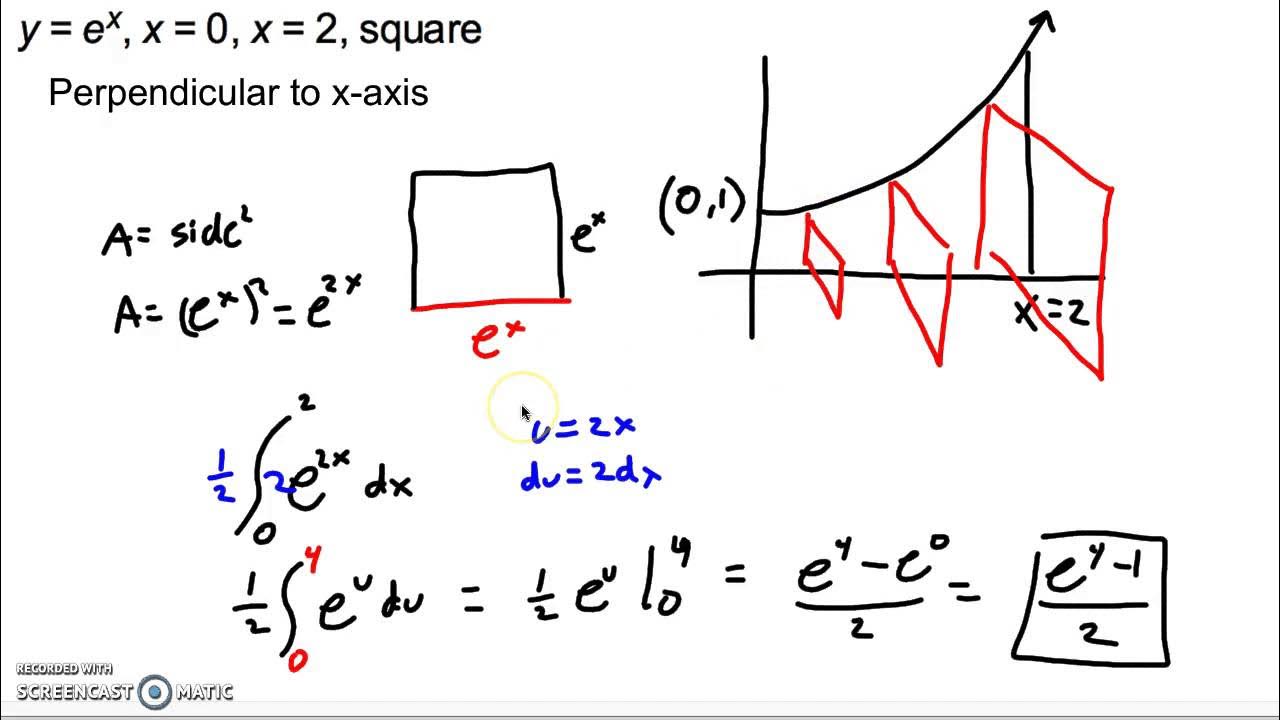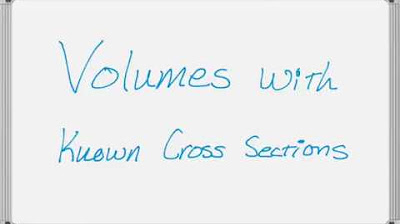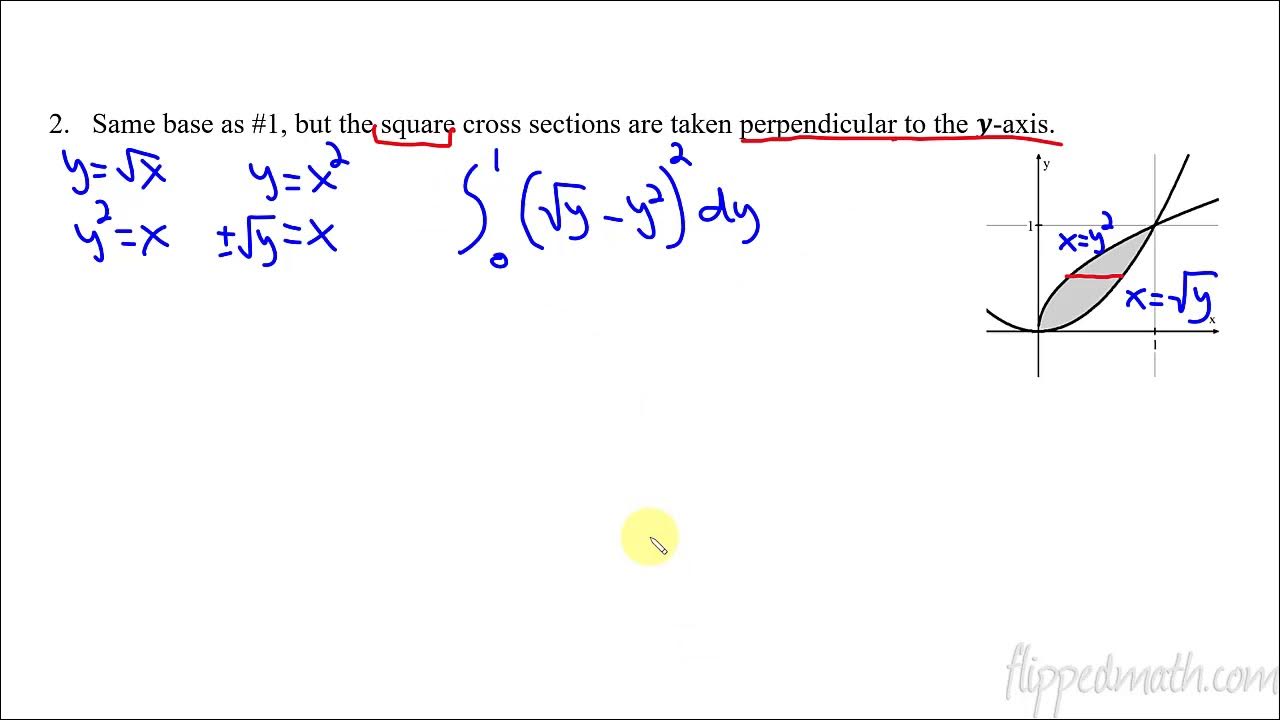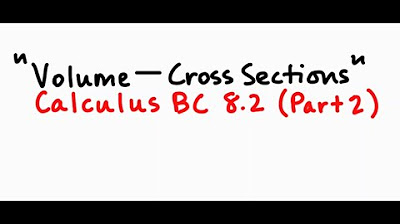Volumes Using Cross Sections - Calculus
TLDRThe video script presents a comprehensive guide on calculating the volume of a solid using cross sections. It introduces two key formulas for integration, depending on the orientation of the cross sections relative to the axes. The script demonstrates the application of these formulas through two problems: one involving a solid bounded by the x-axis and a line y=√x, and another by the x and y axes and a line y=4-x/2. The step-by-step explanations include graphing the functions, deriving the area functions, and performing the necessary integrations to find the volumes. The detailed breakdown of the calculations and the use of visual aids make the concepts accessible and understandable.
Takeaways
- 📚 The video discusses finding the volume of a solid using cross sections and integration.
- 📈 Two formulas are introduced for calculating volume: one using x-axis cross sections and another for y-axis cross sections.
- 🌟 The first example involves a solid with cross sections perpendicular to the x-axis, using the function y = √x bounded by the x-axis and x=4.
- 📊 The area function for the first solid is derived as A(x) = x, leading to the integral ∫x dx from 0 to 4.
- 🤔 The antiderivative of x is (x^2)/2, and evaluating from 0 to 4 yields a volume of 8.
- 🔍 The second example involves a solid bounded by the x-axis, y-axis, and the line y = 4 - (x/2), with cross sections in the shape of semi-circles.
- 🔢 The area function for the semi-circular cross sections is A(x) = (1/8πy^2), where y is given by the line equation.
- 🧮 The integral for the second solid is ∫(1/8π(4 - (1/2x)^2))dx from 0 to 8.
- 👓 After expanding and integrating, the volume is found using the anti-derivatives of the integrated terms, resulting in a volume expression of (16π/3) cubic units.
- 💡 The video emphasizes the importance of setting up the area function correctly in relation to the axis of symmetry for accurate volume calculation.
- 📝 The process of finding the volume of a solid involves understanding the geometry of the cross sections and the appropriate integration techniques.
Q & A
What are the two formulas mentioned in the video for finding the volume of a solid using cross sections?
-The two formulas mentioned are: 1) the volume found using the integration from a to b of the area function, where cross sections are perpendicular to the x-axis, and 2) an alternative formula where c and d are y values, and cross sections are perpendicular to the y-axis.
What is the equation of the function and the bounds used in the first example of the video?
-The equation of the function used in the first example is y = sqrt(x), and it is bounded by the x-axis and the line x = 4.
How is the area function derived in terms of x for the first example?
-The area function in terms of x for the first example is derived by recognizing that the cross-sectional area (s^2) is equivalent to y^2, and since y is the square root of x, the area function becomes A(x) = x.
What is the antiderivative of x with respect to x, and how is it used to find the volume in the first example?
-The antiderivative of x with respect to x is x^2/2. It is used to find the volume by integrating the area function A(x) = x from 0 to 4.
What is the second function's equation and how is it rewritten for easier graphing?
-The second function's equation is y = 4 - x/2. It is rewritten in slope-intercept form as y = -1/2x + 4.
How is the x-intercept found for the second function?
-The x-intercept is found by setting y to zero and solving for x. After multiplying both sides by 2, the equation becomes -x + 8 = 0, which simplifies to x = 8.
What shape are the cross sections in the second example, and how is the area of the cross section expressed in terms of x?
-The cross sections in the second example are semi-circles. The area of the cross section, in terms of x, is expressed as (1/8)π(y)^2, where y is equal to s, the diameter of the semi-circle.
How is the area function in terms of x derived for the second example?
-The area function in terms of x for the second example is derived by substituting y with the function's equation (4 - x/2) into the area formula for the semi-circle, resulting in (1/8)π(4 - x/2)^2.
What is the antiderivative of the area function for the second example, and how is it evaluated?
-The antiderivative of the area function for the second example is (1/4)πx^3/3 - 4x + 16x, with the bounds from 0 to 8. It is evaluated by substituting the bounds into the antiderivative and simplifying the expression.
What is the final volume of the solid in the second example, and how is it simplified?
-The final volume of the solid in the second example is (16π)/3. It is simplified by canceling out common factors and reducing the fraction to its lowest terms.
What is the decimal value of the volume of the solid in the second example, and how is it calculated?
-The decimal value of the volume of the solid in the second example is approximately 16.755. It is calculated by dividing 16 by 3 and then multiplying by π.
Outlines
📊 Finding the Volume of a Solid with Cross Sections
This paragraph introduces the concept of calculating the volume of a solid using cross sections. Two formulas are presented for finding the volume: one using integration with respect to x (area function perpendicular to the x-axis) and the other with respect to y (area function perpendicular to the y-axis). The paragraph then proceeds to solve a specific problem where the cross sections are perpendicular to the x-axis, using the function y = √x and integrating from x=0 to x=4. The key steps involve expressing the area function in terms of x, integrating, and evaluating the antiderivative to find the volume, which is ultimately 8 cubic units.
📈 Volume Calculation with Semi-Circular Cross Sections
The second paragraph focuses on finding the volume of a solid bounded by the x-axis, y-axis, and the line y = 4 - (x/2) using semi-circular cross sections perpendicular to the x-axis. The explanation begins by graphing the given line and finding its x and y intercepts. It then transitions to calculating the area of the cross sections, which are semi-circles, using the formula for the area of a semi-circle (1/2 * π * r^2). The area function is expressed in terms of x, and the integration is set up to find the volume. The paragraph concludes with the process of integrating the area function from 0 to 8, including the steps of foiling and evaluating the antiderivative to arrive at the final volume, which is 64π/3 cubic units.
🔢 Simplifying the Volume Calculation
In this final paragraph, the focus is on simplifying the calculations from the previous paragraph to find the volume of the solid. The paragraph begins by distributing the 1/8 factor across the terms in the volume expression, which simplifies the integration process. The anti-derivative of the simplified function is then evaluated from 0 to 8, and the constant terms are simplified. The final step involves dividing by 12 and reducing the fraction to obtain the simplified volume expression, 16π/3. The paragraph also mentions how to obtain the decimal value of the volume by entering 16π/3 into a calculator, resulting in approximately 16.755 cubic units.
Mindmap
Keywords
💡Volume
💡Cross Sections
💡Integration
💡Area Function
💡Antiderivative
💡Graph
💡Semi-Circle
💡Diameter
💡Coordinate Axes
💡Bounded
💡Pi (π)
Highlights
The video reviews how to find the volume of a solid using cross sections, providing a comprehensive understanding of the topic.
Two formulas are introduced for calculating the volume of a solid, depending on whether the cross sections are perpendicular to the x-axis or y-axis.
A detailed explanation of the first formula is given, which involves integrating the area function from a to b, with cross sections perpendicular to the x-axis.
A graph of y = sqrt(x) is drawn to illustrate the first problem, showing the cross sections as squares and the area function in terms of x.
The area of the square cross sections is shown to be equal to y^2, which is derived from the function y = sqrt(x).
The integration process for the first problem is demonstrated, with the antiderivative of x being x^2/2, resulting in a volume of 8 cubic units.
An alternative graphical representation is provided for the first problem, emphasizing the visualization of the cross sections and their areas.
The second problem involves finding the volume of a solid bounded by the x-axis, y-axis, and the line y = 4 - x/2, using cross sections of semi-circles.
The area of the semi-circle cross sections is derived, with the formula being 1/8πy^2, where y represents the diameter of the semi-circle.
The area function is expressed in terms of x by replacing y with 4 - x/2, leading to the integral formula for calculating the volume.
The integration of the area function is performed, resulting in a complex expression that needs to be simplified to find the volume.
The anti-derivative of the integrated function is calculated, with the final volume being 16π/3 cubic units.
A decimal value for the volume is provided, which is approximately 16.755 when calculated using a calculator.
The video effectively combines mathematical theory with practical graphical illustrations to enhance understanding of finding the volume of solids.
The method of cross sections is highlighted as a crucial approach in calculating the volume of complex solids.
The importance of correctly setting up the area function in terms of the appropriate axis is emphasized for accurate volume calculation.
The video demonstrates the process of integrating a function, including the use of the constant multiple rule and the proper handling of terms during evaluation.
The concept of semi-circle cross sections is introduced, showcasing the application of circular geometry in volume calculation.
The video concludes with a clear demonstration of how to find the volume of a solid using cross sections, reinforcing the key concepts and methods.
Transcripts
Browse More Related Video
5.0 / 5 (0 votes)
Thanks for rating:





